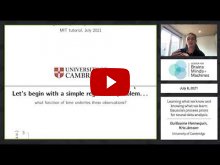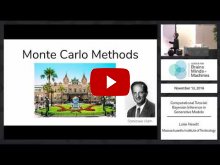Computational Tutorials Recordings
Recordings
Jul 8, 2021
Guillaume Hennequin, Kris Jensen - University of Cambridge
Colab notebooks:
Introduction to FA and GPFA as probabilistic generative models
Fitting an example data set from a primate reaching task with GPFA
Additional papers and resources
Rasmussen & Williams (2006) - The standard textbook...
Apr 8, 2021
Mechanistic studies of complex, ethological animal behaviors are poised to define the next decade of neuroscience. Fully understanding the ontogeny, evolution, and neural basis of these behaviors requires precise 3D measurements of their underlying kinematics. While 2D convolutional networks have...
Nov 19, 2020
Recurrent neural networks (RNNs) are a powerful model for neural and cognitive phenomena. However, interpreting these models can be a challenge. In this tutorial, we will discuss how dynamical systems theory provides some tools for understanding RNNs. In particular, we will focus on the theory and...
Sep 22, 2020
Christian Bueno, University of California, Santa Barbara
Working with lower dimensional representations of data can be valuable for simplifying models, removing noise, and visualization. When data is distributed in geometrically complicated ways, tools such as PCA can quickly run into limitations...
Sep 3, 2020
Lookit is an online platform for designing and running asynchronous developmental studies. This technology allows for more diverse and representative populations to participate in developmental studies than would typically be able to engage in the research process (e.g. participation at a children'...
Jul 23, 2020
Machine learning models today achieve impressive performance on challenging benchmark tasks. Yet, these models remain remarkably brittle---small perturbations of natural inputs, known as adversarial examples, can severely degrade their behavior.
Why is this the case?
In this tutorial, we take a...
Jul 9, 2020
Talmo Pereira, Princeton University
Behavioral quantification, the problem of measuring and describing how an animal interacts with the world, has been gaining increasing attention across disciplines as new computational methods emerge to automate this task and increase the expressiveness of these...
Apr 11, 2019
Kelsey Allen, MIT
Common intuition posits that deep learning has succeeded because of its ability to assume very little structure in the data it receives, instead learning that structure from large numbers of training examples. However, recent work has attempted to bring structure back into deep...
Apr 2, 2019
Speaker: Omar Costilla Reyes, PhD
Neural decoding has applications in neuroscience from understanding neural populations to build brain-computer interfaces. In this computational tutorial, I will introduce neural decoding principles from a machine learning perspective using the Python programming...
Nov 13, 2018
Speaker: Luke Hewitt, MIT
Talk prepared and Q&A session by: Maddie Cusimano & Luke Hewitt, MIT
Bayesian inference is ubiquitous in models and tools across cognitive science and neuroscience. While the mathematical formulation of Bayesian models in terms of prior and likelihood is simple,...
Apr 19, 2018
The ability to identify interpretable, low-dimensional features that capture the dynamics of large-scale neural recordings is a major challenge in neuroscience. Dynamics that include repeated temporal patterns (which we call sequences), are not succinctly captured by traditional dimensionality...
Sep 5, 2017
Taught by: Alex Williams, Stanford University
In many scientific domains, data is coded in large tables or higher-dimensional arrays. Compressing these data into smaller, more manageable representations is often critical for extracting scientific insights. This tutorial covers matrix and tensor...












![Embedded thumbnail for Dimensionality Reduction for Matrix- and Tensor-Coded Data [Part 1] (53:36)](https://cbmm.mit.edu/sites/default/files/styles/youtube_thumbnail_220w/public/youtube/hmmnRF66hOA.jpg?itok=qfX6mqaC)